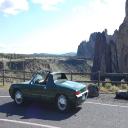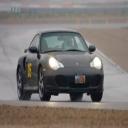Yahoo Answers is shutting down on May 4th, 2021 (Eastern Time) and beginning April 20th, 2021 (Eastern Time) the Yahoo Answers website will be in read-only mode. There will be no changes to other Yahoo properties or services, or your Yahoo account. You can find more information about the Yahoo Answers shutdown and how to download your data on this help page.
Trending News
Hubcentric wheel spacer lengths?
Already aware of the pros and cons of wheel spacers. That set aside.... what do i need for spacers as I am horrible at understanding the "even length" thing and am getting conflicting information. I've been told "Get the same length spacers all around" and "Just make sure the wheels end up the same" and "Only go this much". So to clear it up, whoever can give me the best justification of size, how far to go out and get it correct gets 10 points and my enormous thanks.
This is for a 1984 Porsche 944. Stock sizes are as follows. Front is 7"x15"@23mm rear is 8"x15"@11mm (with a seemingly 3/4" spacer stock)
The NEW wheels are off a 1996 911 Targa. They are as follows: Front 7"x17"@55mm, rear is 8.5"x17"@50mm.
What spacers do i need front and back in hubcentric to make it "flush" and "correct" as intended. Again, thank you for your time in answering the question and the best answer gets the points. Again this is not a debate question, it is a simple question of what is necessary to get them fitted correctly.
Again, I'm not here to debate about the spacers. They are hubcentric spacers, not spaced metal sheets as with most spacers. Again, either list information or please don't answer, i'm well aware of pros and cons, these are HUBCENTRIC wheel spacers, not standard bolt spacers. Meaning the spacers actually bolt to the hub, and then the wheels bolt to the opposite end of the spacer, not spaced lug spacers. Again, not here to debate. Want measurements and assistance, not a debate.
3 Answers
- designergenesLv 61 decade agoFavorite Answer
Check out http://www.optionimports.com/spacers.html . This link includes a phone number to call to achieve the fitment you need.
With the spacer you've got in the rear now, probably 19mm, you're going from 23mm front and 30mm rear to 55mm front and 40 mm rear, assuming you continue using the "stock" rear spacer. The offset is the distance from the center line of the wheel's width to the actual plane of the wheel's bearing on the hub. Note that you are not running with "the wheels the same" now.
Positive offsets indicate that the bearing plane is outboard of the center line of the wheel; negative offsets mean the plane is inboard (on the brake side) of the wheel's center line. Positive offsets move the wheel closer to the brake and negative ones move it outboard, closer to the wheel well arch of the fender. Diagram this if it's hard to visualize; a picture is worth a thousand words.
The point is to not scrub either the fender arch or the inside of the wheel well when turning full over.
You are changing wheel widths very little. At the same time you're moving to larger diameter wheels (and tires, dependent on the aspect ratio such as 30 or 45 or 50 in the (example) ZR30x17, etc. tire size) and that's not so good in terms of scrubbing. It's the tires, not the wheels that will or will not scrub.
If the width, in millimetres of the tires is no greater than you used on the old wheels, and the aspect ratio is smaller, you might be increasing your chances of scrubbing very little.
However, you are definitely moving all of the wheels inboard, and so you risk scrubbing during turns at the front wheel wells. You need to measure your clearances to the fender arches and to the back walls of the front wells to see just how much closer you'll be.
Check out the diagram on the link; it's helpful. You're making fairly small offset changes; it's the tire diameters that should be your biggest concern
One more thing to consider. You do not want to create a large difference in the outside diameters of the front and real tires. You shouldn't change the aspect ratios of the tires you mount on your new wheels much if at all from the ones you used on your old wheels. Ask the tires guys to help you with this. It's all about the wheel offsets AND the tire widths/aspect ratios.
Source(s): The site link I've included and others. I'm a mechanical engineer. - 5 years ago
what your trying to do,,is not really safe,,the part your looking for can be found,,but some aren,t worth buying,,it would be in your best interest to sell the wheel,s,,and find a set that will bolt on,without having to have spacer,s,i seen a bad accident,,once because someone had used wheel spacer,s,,the lug nut,s have a tendency to work loose on them,,be safe,,hope this help,s you.
- 1 decade ago
If you have already purchased the wheels then it might be too late. Spacers shouldnt be used because of added leverage and stress on the studs or in this case I think you have lug bolts. There are correct wheels out there with the right back space and offset, so you dont have this issue. In 10 years of dealing with cars and trucks Ive seen 9 or 10 vehicles loose a wheel while moving. If im correct your vehicle has lug bolts. If you space the wheels, less bolt will be threaded into the hub. If you do space them, get longer bolts. Like I was saying, get the correct fitment and dont rig it. Its dangerous.
Source(s): years of wheel and tire fitments.





